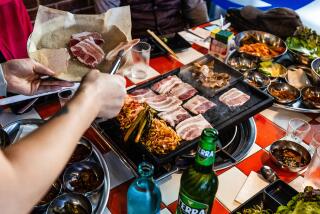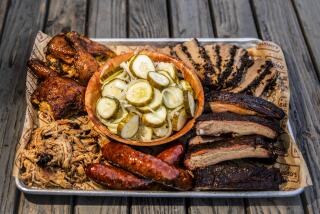A barbecue master’s signature sauce
- Share via
If you love outdoor cooking, there’s nothing like taming a tough cut of meat through the mastery of a low and slow fire, or deftly handling a lean cut quickly over a hot grill. But often it’s that signature touch -- a thoughtfully honed sauce -- that separates barbecue masters from weekend warriors.
At once sweet, sour and spicy, the best sauces achieve a controlled balance of what might initially seem like contradictory flavors. These aren’t run-of-the-mill sauces, mass-produced and available at any market. These sauces are special, and you tailor them to fit whatever you’re cooking at the time.
Start with a foundation. Most traditional barbecue sauces are tomato-based, drawing on tomato sauce, fresh or canned tomatoes, ketchup or a combination of these. There are also vinegar-, mustard-, broth- and even mayonnaise-based barbecue sauces.
From there, add ingredients one or two at a time and taste carefully; you’re looking for balance. Sweeten the sauce with sugar, or other options such as maple syrup, brown sugar or even molasses. (Because sugar burns easily, most barbecue sauces should be applied at the last minute to avoid scorching.)
Give the sauce a tart note with any of a variety of vinegars, or try citrus juice or zest. Consider fresh or ground spices and herbs, and adjust the heat with fresh or dried peppers or hot sauce. Then season the sauce; add a little salt, or deepen the flavor with soy or Worcestershire sauce.
Allow the mixture to cook slowly to give the ingredients time to mature and marry, much as you would with a homemade tomato sauce or chili. Like the best barbecue, a great sauce develops slowly, its flavor improving with time.
Finally, consider taking the sauce to the next level by adding one or more signature ingredients. Think fruit juice, coffee or cola, chiles, agave nectar, horseradish or an unusual spice.
Liquid smoke may be controversial in some circles for health reasons, but it can lend depth to a sauce, particularly when the meat is not smoked or grilled over an open flame but cooked on a stove-top grill or slow-cooked in an oven.
One fun route is using liquor. For a Kentucky bourbon barbecue sauce, simmer some onion and garlic in a couple of cups of bourbon. A slow simmer will soften the onion and garlic, and the bourbon will mellow to buttery richness as the alcohol cooks off.
The foundation of this sauce is ketchup and tomato paste. Sweeten it with brown sugar and molasses, then balance that by adding cider vinegar, pineapple and lemon juice (pineapple and lemon juice are natural complements to bourbon). Add depth with Worcestershire sauce, salt, liquid smoke and dry mustard, then spice it just a bit with a little hot sauce and chile powder.
Slightly sweet, the sauce is perfect mopped over pecan-crusted pork spareribs. Coat the ribs with a seasoned wet rub of Dijon mustard, brown sugar and chopped pecans, then cover and bake them over low heat for two to three hours until they’re meltingly tender. Shortly before they’re done, uncover them and baste them with the barbecue sauce; the sauce will thicken to a beautiful shellac. Serve the ribs hot, with a stack of napkins.
Or go a different route. Fruit is an increasingly popular ingredient in barbecue sauces, but it must be used with discretion. You don’t want barbecue sauce to taste like jam. Roast fresh whole cherries in a little almond oil. (Almonds heighten the flavor of the cherries.)
While the cherries are roasting, saute some onion with garlic and orange zest in a heavy pot until translucent, then stir in some fennel, chipotle and cumin powder to balance the sweetness.
Puree the sauce, then add some whole cherries to give the final sauce added texture. The finished sauce is rich with flavor, not too sweet and perfect for stuffed pork chops or chicken.
Barbecue often revolves around pork, but in Texas, beef brisket shares the spotlight. For this, you want a sauce that’s a little more acidic to balance the richness of the beef and the power of the hickory smoke.
This is a ketchup-based sauce, but it gets its personality from peppers cooked down with beer and super-strong coffee. It is rich with a gentle kick, not sweet, and tart enough to stand up to the complex flavors of a hickory-smoked brisket.
Finding your own sauce is a matter of balancing flavors and careful cooking. Trust your taste and don’t be afraid to experiment. Barbecue sauces have a mystique about them, but developing your own signature style isn’t rocket science.
--
--
Pecan-crusted spareribs with Kentucky bourbon barbecue sauce
Total time: 1 hour, 10 minutes, plus about 3 hours cooking time for the ribs
Servings: 10 to 12
Note: This is my version of a popular sauce. Make the barbecue sauce at least 3 days in advance to allow the flavors to develop. This makes about 7 cups of sauce, more than is required for this recipe. The sauce will keep up to 2 weeks, refrigerated.
Kentucky bourbon barbecue sauce
1 large onion, thinly sliced, top to bottom
6 cloves garlic, crushed
Juice and grated zest of 1 lemon, divided
2 cups Kentucky bourbon
1 teaspoon black pepper
2 teaspoons chile powder
1 teaspoon dry mustard
1 1/2 teaspoons onion powder
1 tablespoon salt, or more to taste
1/2 cup tomato paste
4 cups ketchup
1/2 cup cider vinegar
1/4 cup pineapple juice
1/4 cup liquid smoke
1/2 cup Worcestershire sauce
2/3 cup dark brown sugar
1/3 cup molasses
1/2 teaspoon Tabasco, or other vinegar-based hot sauce
2 dashes bitters
1. In a heavy-bottom 4-quart pot, combine the onion, garlic, lemon zest and bourbon. Bring the bourbon to a simmer over medium-high heat, then reduce the heat to maintain a simmer and continue to cook until the onion is translucent, about 10 minutes.
2. Stir in the lemon juice, pepper, chile powder, mustard, onion powder, salt, tomato paste, ketchup, vinegar, pineapple juice, liquid smoke, Worcestershire sauce, brown sugar, molasses, Tabasco and bitters and continue to gently simmer for 30 minutes. Stir frequently, making sure to scrape the bottom of the pot to prevent burning.
3. Remove from heat and puree the sauce until fairly smooth, using an immersion blender or blending in stages in a stand blender. Place the sauce in a nonreactive container and set aside until it comes to room temperature, then cover and refrigerate until needed. Warm the sauce before using.
Pecan mustard rub and assembly
2 whole racks pork spareribs
1 tablespoon salt
Freshly ground pepper
4 teaspoons chopped garlic
3/4 cup Dijon mustard
1 cup brown sugar
2 tablespoons chile powder
1 tablespoon onion powder
1/2 teaspoon Tabasco, or other vinegar-based hot sauce
4 cups chopped pecans
1/2 cup beer
Kentucky bourbon barbecue sauce
1. Heat the oven to 250 degrees.
2. Peel the tough membrane lining the underside of the spareribs, then rinse the ribs, pat dry and place in a large roasting pan.
3. Evenly coat the racks on both sides with the salt, several grinds of pepper and the garlic. Set the racks aside while you make the rub.
4. In a medium bowl, combine the mustard, sugar, chile powder, onion powder and Tabasco to form a thick paste. Stir in the pecans until combined; this will form a sticky wet rub.
5. Rub the pecan mixture evenly over the rib racks on both sides to coat. Pour the beer into the roasting pan, then cover tightly with foil.
6. Place the ribs in the oven and cook until the meat is tender and curled away from the ends of the ribs (you should see about one-half inch of bone at the end of each rib), about 2 1/2 hours.
7. Remove the foil from the pan and mop the ribs with a generous coating of barbecue sauce. Cook the ribs an additional 30 minutes to allow the barbecue sauce to thicken and form a “crust” on top of the ribs. Remove from heat and allow the ribs to cool slightly. Slice and serve immediately with additional barbecue sauce on the side.
Each of 12 servings: 834 calories; 35 grams protein; 40 grams carbohydrates; 4 grams fiber; 58 grams fat; 14 grams saturated fat; 128 mg. cholesterol; 1,462 mg. sodium.
--
Hickory-smoked brisket with Southwestern barbecue sauce
Total time: 2 hours, plus 5 to 6 hours smoking time
Servings: 6 to 8
Note: This recipe calls for hickory chips and the use of a smoker, or a charcoal grill converted to a smoker. Hickory chips are available at many well-stocked markets as well as at barbecue supply stores. The barbecue sauce makes about 6 cups, more than is needed for this recipe. Any remaining sauce will keep up to 1 week, refrigerated.
Hickory-smoked brisket
1 tablespoon kosher salt
1 teaspoon freshly ground pepper
1/2 teaspoon onion powder
1/2 teaspoon cumin
1/2 teaspoon garlic powder
1 (3- to 4-pound) beef brisket with a layer of fat no thicker than 1/2 -inch
4 cups beer
2 cups water
Hickory chips, soaked
1. In a small bowl, combine the salt, pepper, onion powder, cumin and garlic powder. Rub the mix into the brisket and let sit at room temperature, 45 minutes to 1 hour.
2. Meanwhile, prepare your smoker or grill to cook over low, indirect heat for several hours. Set up a drip pan underneath where the brisket will smoke, and fill with the beer and water. Shortly before cooking, adjust the heat as needed to maintain a temperature around 250 degrees, and add hickory chips to start smoking.
3. Place the brisket (fat side up) in the prepared smoker and cook for 2 1/2 hours. Adjust the heat as needed (add several coals to either side of the grill as needed if using a kettle grill) to maintain the ambient temperature (around 250 degrees); replenish the chips as needed to keep smoking. Baste the brisket every 30 minutes or so to keep it moist.
4. After 2 1/2 hours, wrap the brisket (fat side up) tightly in foil and continue to cook over indirect low heat until the meat is fork-tender, 3 to 4 additional hours (time may vary depending on the heat of the smoker and size and thickness of the brisket).
5. Remove the brisket from heat and, still wrapped in foil, cover it with a layer of newspaper and kitchen towels to keep warm. Set aside, covered, for at least 1 hour before serving. While the brisket is resting, make the sauce.
Southwestern barbecue sauce and assembly
1 large onion, thinly sliced, top to bottom
3 cloves garlic, crushed
2 jalapenos, seeded and diced
2 poblano or pasilla chiles, seeded and diced
1/2 cup strong brewed coffee
1 beer, preferably ale
2 tablespoons tomato paste
3 cups ketchup
1/4 cup maple syrup, preferably Grade B
1/4 cup molasses
1 tablespoon cumin
2 teaspoons salt
1 teaspoon New Mexico chile powder
1/3 cup red wine vinegar
Prepared smoked brisket
1. In a heavy-bottom 4-quart pot, combine the onion, garlic, jalapenos and chiles with the coffee and beer. Bring to a simmer over medium-high heat, then reduce the heat and simmer until the onion is translucent, about 10 minutes.
2. Stir in the tomato paste, ketchup, maple syrup, molasses, cumin, salt, chile powder and red wine vinegar and simmer for 20 minutes, stirring occasionally. Remove from heat and blend the sauce using an immersion blender or in stages in a stand blender, until fairly smooth. Set aside.
3. Remove the brisket from the foil and slice across the grain into thin strips, reserving any pooled juices and leftover bits. Stir these drippings into the barbecue sauce. Serve the brisket warm with the barbecue sauce on the side.
Each of 8 servings: 667 calories; 37 grams protein; 19 grams carbohydrates; 1 gram fiber; 44 grams fat; 18 grams saturated fat; 161 mg. cholesterol; 1,077 mg. sodium.



